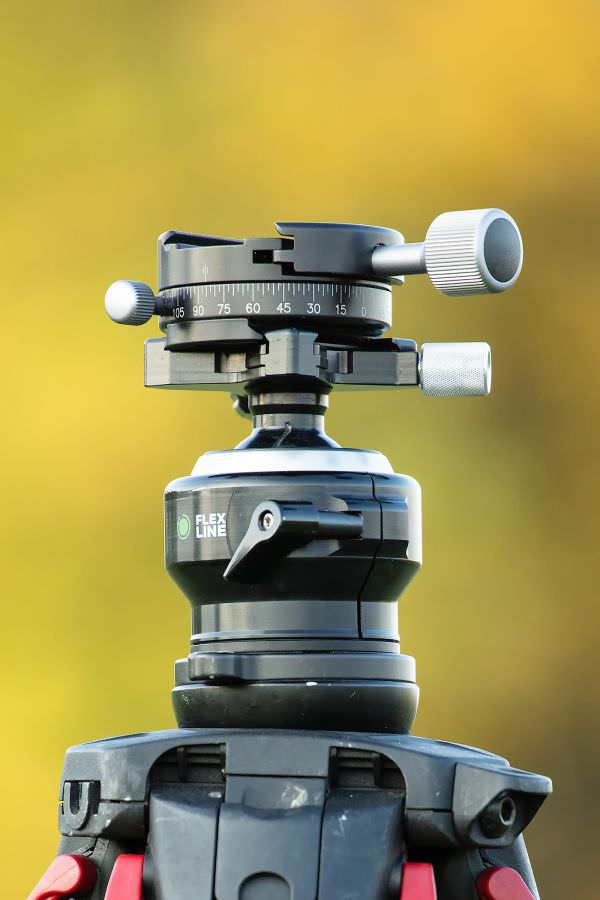FlexShooter Pro Tripod Head Review
Updated 4th January 2023
This ingenious ball head is comprised of two separate balls within an outer sleeve. The larger silver ball incorporates a bubble level that is used to accurately level the inner ball. Once level the smaller spring counter-balanced inner ball does all the work – acting like a cross between a two-way pan and tilt head and a gimbal. For several years the FlexShooter Pro has been my tripod head of choice when travelling.

When travelling overseas to shoot both landscape and wildlife subjects my first choice tripod heads used to be my Sachtler FSB-6 fluid head and Really Right Stuff BH-55 Pro ball head. The combined weight of these is 3387g, so I would only take them both if they could be packed in a Peli case in the aircraft hold. Where weight of equipment was a concern I would instead take my BH-55 Pro ball head along with a Wimberley Sidekick. The combined weight of this is 1408g and the operation of the Sidekick with big telephoto lenses falls well short of the Sachtler head, but is acceptable at a pinch. Then along came the FlexShooter Pro that covers all bases really well in an extremely compact package with a weight of only 676g!
That’s such a significant weight saving that I could end my review there and you’d probably still head off to the FlexShooter website! But let's delve a little deeper into the pros and cons of this intriguing spring counter-balanced double ball head.
Switching between my fluid head and ball head obviously takes time … only a few seconds, but as we all know that can mean the difference between getting the shot and missing out. It’s also inevitable that when a great subject presents itself I often have the wrong head on at the time! With the FlexShooter Pro I can simply switch from one camera set-up to another without having to change the head over, gaining valuable seconds and hopefully securing the shot … it is always the right head to have on!

When I first saw the FlexShooter Pro I must admit to being pretty sceptical that such a compact ball head would be able to balance my Canon R5 and 600mm lens whilst providing a smooth panning action. It looked physically impossible. However, when I attached this particular camera and lens combination I was amazed just how well it handled the weight. In fact, the heavier the lens the smoother the action seems to become! Once properly levelled and balanced it really does render it practically weightless. I can spin it around with one finger and wherever it stops it stays – no dipping or creeping to spoil my chosen composition.
I would not describe the smoothness of movement as like a gimbal head or a traditional fluid video head. … it is different in a way that is difficult to describe. I’m not saying it is not smooth, because it is. It is just slightly different. Because of this it might take a bit of getting used to, but that said, I quickly got used to mine! The amount of resistance can be fine-tuned very nicely using the single silver knob, all the way from completely loose to locked tight. Personally I prefer the action of the FlexShooter Pro to any gimbal head I have ever used, including the Gitzo Fluid Gimbal. Because of its compact design there is far less vibration transmitted through the lens and it generally feels more stable. I have so far found it to be considerably better than a gimbal head in two situations; firstly when shooting in low light at slow shutter speeds and secondly when using a remote release to trigger the shutter (and therefore not using good “hands-on” long lens technique). I’m sure the improvement in both these situations is due to reduced vibration transmitted through the lens, including the shutter shock that the R5 body suffers from.

When using a zoom lens (with external zoom such as the Canon 100-400mm or Nikon 80-400mm) on a gimbal or fluid head it is important to readjust the centre of balance after making significant changes in focal length. Although it is preferable to do the same with the FlexShooter Pro, I have found it to be much less important. A simple adjustment of the tension using the silver knob compensates adequately for slight shifts of the centre of balance. Having said that, as with gimbal and fluid heads, it is worth marking your lens foot/plate to show the point at which centre of gravity is achieved. On super telephoto lenses this should be done for the bare lens and with separate marks for when a 1.4X or 2X extender/teleconverter is attached. This enables speedier set-up in the field.
Compared to my Sachtler fluid video head the FlexShooter Pro does fall slightly short in terms of both smoothness of movements and overall stability. However, this is to be expected in a head that is almost four times smaller and lighter and with no fluid damping! Once you take this into account the FlexShooter Pro compares remarkably well, but I will be sticking with my Sachtler in situations where its weight, and the fact that I have to carry a separate ball head for shooting landscapes, are not an issue.
One other area of concern is the restricted angle of tilt that can be applied, which makes shooting both high up and low down subjects quite tricky. Initially I thought this could be a major drawback. However, to be honest I rarely shoot beyond the angles at which the FlexShooter Pro is capable. In general I like to be as close to eye-level as possible when shooting wildlife subjects and the fact that the FlexShooter head stiffens up when it gets past a certain angle is basically telling me that I shouldn’t really be shooting! If you really want to shoot a subject at such an extreme angle it is still possible by simply releasing the silver outer ball, at which point the FlexShooter Pro acts just like a normal ball head.

The Arca-Swiss style quick release clamp looks a little different as it is designed for minimal weight, so there are dovetails only on the four corners. This doesn’t seem to affect it’s clamping force at all, but it can make seating the lens plate quite tricky compared to the other clamps I use. Again, I quickly got used to it and no longer consider it an issue. The Flexshooter Pro is now available with a lever release clamp, but personally I prefer the screw clamp.
I was even more sceptical as to whether the FlexShooter Pro would be suitable for landscape photography. The design seemed to have one obvious shortcoming in that shooting panoramas could be quite difficult (more on that later}. However, as soon as I began shooting landscapes I was immediately converted. With a slight adjustment to my workflow this quickly became my favourite head for shooting landscapes! Once you get the silver outer ball level (this takes but a few seconds) you are then free to move the camera in any direction, but it will always remain level. When you let go it remains exactly where it is without tightening any knobs, so there is none of the dreaded “creep” that you often have to take into account when using a normal ball head. This really helps to speed things up if you’re constantly adjusting your composition in rapidly changing light or in misty conditions where many different compositions are presenting themselves. You will need to use an L-bracket on your camera when using shorter focal length lenses without tripod collars.
The quick levelling function is also of great benefit when shooting wildlife, especially if you’re setting your tripod up on uneven ground. By quickly levelling the silver outer ball you can be sure that wherever you point your camera the horizon will be level. I was already used to this technique from using a video head, but for some this extra step will take some getting used to. It will quickly become second nature and the small amount of time spent accurately levelling the head before shooting will always be worthwhile.
There will of course be occasions where you simply need to plonk your tripod down and begin shooting straight away. Again, by simply turning the small black knob to release the silver ball the FlexShooter Pro behaves just like a traditional ball head with free movement in all directions.

The FlexShooter Pro does not allow you to pan independently from other movements, making shooting landscape panoramas rather tricky. My solution to this is a Really Right Stuff panning clamp that mounts between the FlexShooter Pro and the camera or lens. My workflow for this is to set the tripod up and level the outer ball - adjust my composition using the inner ball - lock the inner ball using the silver knob and then shoot my stitched panorama using the pan function of the panning clamp. This is practically the same method I used with my Really Right Stuff BH55 Pro ball head, but with the FlexShooter it’s slightly easier because I can make slight adjustments to the composition without the risk of ever losing my level horizon.

- FlexShooter Pro 676g
- Really Right Stuff BH-55 Pro 872g
- Gitzo GHFG1 Fluid Gimbal 1380g
- Sachtler FSB-6 2515g
- Wimberley Sidekick 536g
Summary:
Advantages:
Significant weight saving
- Much smaller than most alternative heads
- Works well for a variety of subjects and therefore no need to carry two heads
- No need to tighten knobs to lockdown and therefore no “creep”
- Excellent build quality
- Intelligent design
- Works with lenses from wide-angle to super telephoto
- Camera remains level no matter where you point it
- Easily supports up to 600mm lens with extenders/teleconverters
Disadvantages:
- Not quite as smooth or adjustable as a true fluid video head
- Restricted tilt angles when utilising counter-balanced inner ball
A few shorter focal length lenses with tripod collars may cause the base of larger camera bodies to foul the FlexShooter Pro’s control knobs. This can be solved by simply mounting the lens in the opposite direction in the clamp. Unfortunately this places the control knobs in a very different position than you will be used to, but it's better than having them almost inaccessibly close to the camera body.
So who’s it for? If you shoot both landscape and wildlife subjects using a variety of lenses up to a long telephoto then this tripod head should be of great interest. If you wish or need to keep the weight of your kit down without sacrificing functionality you should also be very interested. Personally I like this head because it works almost as well as my much bulkier alternatives but allows me to travel more easily by greatly reducing the bulk and weight of my kit. There is a larger FlexShooter Extreme model available but I have not used it yet. With the Pro easily capable of supporting all of the kit that I use, a larger heavier version makes little sense to me. The FlexShooter Pro really is a “Jack of all trades” and whilst it may not be the true master of all of them, I consider it extremely good at all of them and much better than many of the alternatives – most of which would come at both a price and significant weight disadvantage. I know of no other head on the market that offers the same combination of compact size, low weight, versatility and performance. I rate it very highly indeed.
There is a useful instructional video on the Flexshooter website to show exactly how the FlexShooter Pro should be set up for optimal use.
